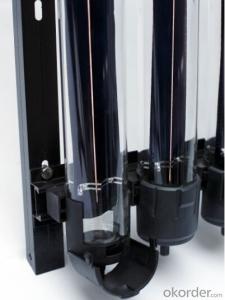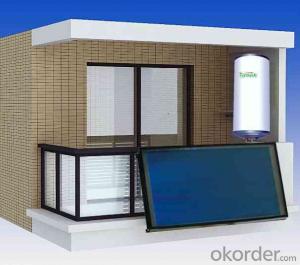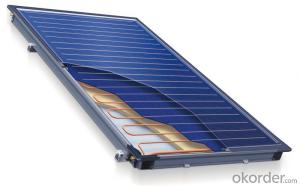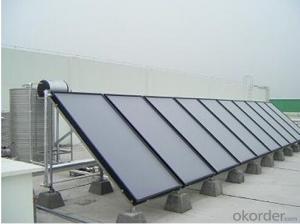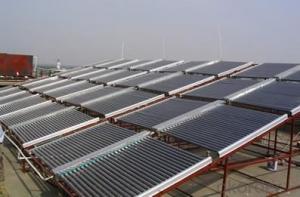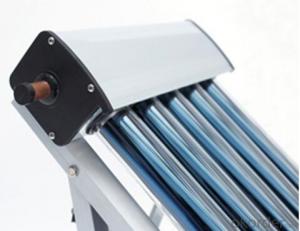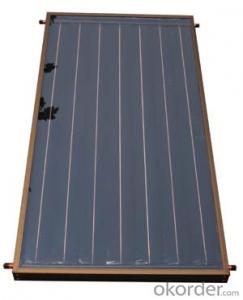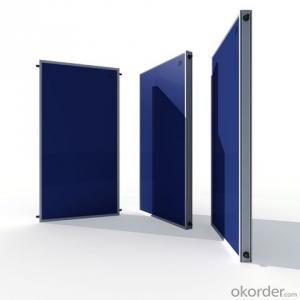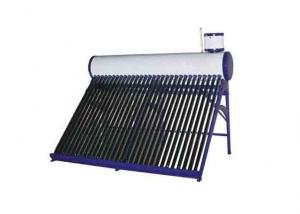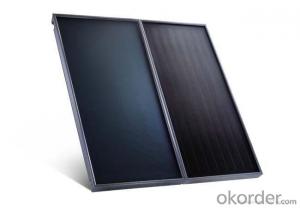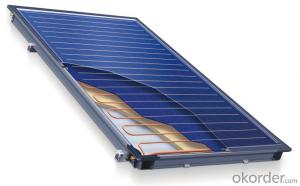Evacuated Tube Solar Collectors Metal Glass Heat Pipe Model SC-HM
- Loading Port:
- Shanghai
- Payment Terms:
- TT OR LC
- Min Order Qty:
- 20 set
- Supply Capability:
- 1500 set/month
OKorder Service Pledge
OKorder Financial Service
You Might Also Like
1. Structure of Metal Glass Heat Pipe for Solar Collector Model SC-HM
This Metal Glass Heat Pipe is an important part for solar collector, and the components are following as shown with graphic:

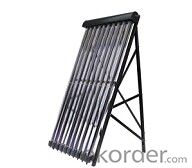
1 Manifold
2 Inlet & Outlet
3 Bracket
4 Metal Glass Vacuum Tube
5 Pipe Supporter
6 Anti-wind Foot
2. Main Features of Metal Glass Heat Pipe for Solar Collector Model SC-HM
The Metal glass vacuum tube is sealed together, high temperature, anti-freezing, insulation with vacuum.
Withφ70 vacuum tube, large collecting area, strong heat collecting efficiency, high temp, rapid heat conducting.
Aluminum alloy manifold & bracket weight less, the surface has treatment of oxidation. It can withstand corrosion resistance.
The super thick insulation layer is Molded rock wool/mineral wool, with high density & low coefficient of heat conductivity
The flow chute is made of high quality brass, with pressure and corrosion resistance, high purity and can withstand 1MPa pressure.
Adjustable pipe supporter and easy for installation.
3. Metal Glass Heat Pipe for Solar Collector Model SC-HM Images
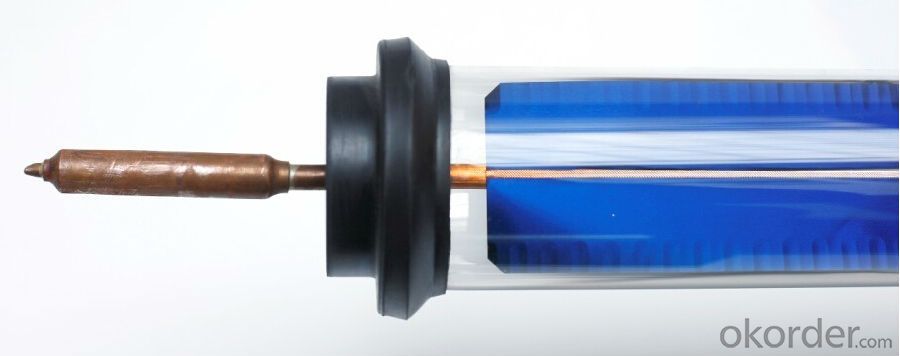
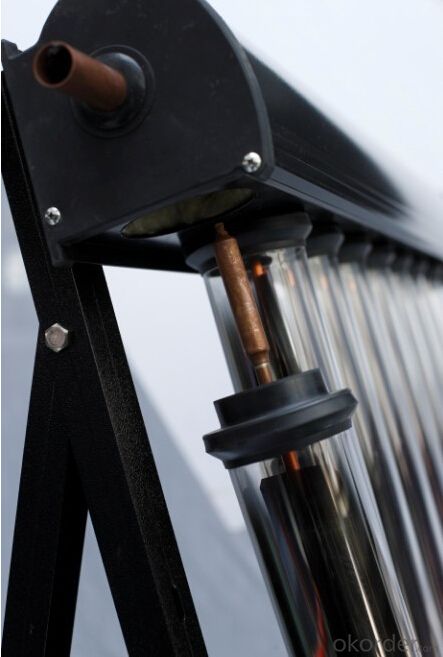
4. Metal Glass Heat Pipe for Solar Collector Model SC-HM Specifications
Model No. | SC-HM-10 | SC-HM-15 | SC-HM-18 | SC-HM-20 | SC-HM-24 | SC-HM-25 | SC-HM-30 |
No.of Vacuum Tube(PCS) | 10 | 15 | 18 | 20 | 24 | 25 | 30 |
Tube Space(㎜) | 100 | 100 | 100 | 100 | 100 | 100 | 100 |
OD/L of Vacuum Tube(㎜) | φ70/2000 | φ70/2000 | φ70/2000 | φ70/2000 | φ70/2000 | φ70/2000 | φ70/2000 |
Material of Vacuum Tube | Borosilicate glass 3.3 | Borosilicate glass 3.3 | Borosilicate glass 3.3 | Borosilicate glass 3.3 | Borosilicate glass 3.3 | Borosilicate glass 3.3 | Borosilicate glass 3.3 |
Material/Thickness of Heat Pipe(㎜) | Coppertp2/0.6 | Coppertp2/0.6 | Coppertp2/0.6 | Coppertp2/0.6 | Coppertp2/0.6 | Coppertp2/0.6 | Coppertp2/0.6 |
OD/Thickness of Flow Chute(㎜) | φ35/1.0 | φ35/1.0 | φ35/1.0 | φ35/1.0 | φ35/1.0 | φ35/1.0 | φ35/1.0 |
OD of Outlet & Inlet | φ22 or 3/4″ | φ22 or 3/4″ | φ22 or 3/4″ | φ22 or 3/4″ | φ22 or 3/4″ | φ22 or 3/4″ | φ22 or 3/4″ |
Insulation Material/Thickness(㎜) | Rockwool/40 | Rockwool/40 | Rockwool/40 | Rockwool/40 | Rockwool/40 | Rockwool/40 | Rockwool/40 |
Working Pressure(MPa) | 0.6 | 0.6 | 0.6 | 0.6 | 0.6 | 0.6 | 0.6 |
Working Temp ℃ | <150 | <150 | <150 | <150 | <150 | <150 | <150 |
Capacity of Solar Collector(L) | 0.69 | 0.98 | 1.15 | 1.27 | 1.50 | 1.56 | 1.85 |
Collecting Area(㎡) | 1.37 | 2.05 | 2.46 | 2.73 | 3.28 | 3.41 | 4.10 |
Total Area(㎡) | 2.20 | 3.28 | 3.92 | 4.35 | 5.21 | 5.43 | 6.50 |
Flow Rate(L/min) | 1.06 | 1.49 | 1.79 | 2.0 | 2.4 | 2.5 | 3.0 |
drop of pressure (Pa) | 16.24 | 41.4 | 63.4 | 81.7 | 127.2 | 140.1 | 219.8 |
Intercept efficiency η0 | 0.77 | 0.77 | 0.77 | 0.77 | 0.77 | 0.77 | 0.77 |
Heat loss rate a W/㎡℃ | 1.9 | 1.9 | 1.9 | 1.9 | 1.9 | 1.9 | 1.9 |
Efficiency(W)1000W/㎡irradiation | 744 | 1044 | 1256 | 1398 | 1681 | 1748 | 2098 |
N.W(kg) | 40.25 | 52.75 | 61.75 | 66.75 | 81.00 | 85.35 | 100.70 |
a (㎜) | 1115 | 1615 | 1915 | 2115 | 2515 | 2615 | 3115 |
b (㎜) | 1025 | 1525 | 1825 | 2025 | 2425 | 2525 | 3025 |
c (㎜) | 950 | 1450 | 1750 | 1950 | 2350 | 2450 | 2950 |
c/2 (㎜) | —— | —— | 875 | 975 | 1175 | 1225 | 1475 |
d (㎜) | 2150 | 2150 | 2150 | 2150 | 2150 | 2150 | 2150 |
e (㎜) | 1375 | 1240 | 1240 | 1240 | 1240 | 1240 | 1240 |
f (㎜) | 1590 | 1590 | 1590 | 1590 | 1590 | 1590 | 1590 |
5. FAQ
1. What happens if one of the solar tubes is broken?
Firstly, tubes are very strong and not easily broken, but if the worst should happen, solar tubes can be replaced very easily. They are inexpensive and available. The solar collectors can operate with several broken tubes, but the efficiency will be reduced, so it is recommended that broken tubes be replaced immediately.
2. Can the solar collectors be mounted on a flat surface?
Yes they may be mounted on a flat roof or on the ground by using a stainless steel Flat Roof Frame. The collector should be installed at a minimum of 20o angle to ensure optimal operation of the heat pipe.
3. Will the solar collector be a fire hazard during hot, dry weather?
No. The solar collector's components are all high temperature rated and non-flammable, so even during strong sunlight with the circulation pump turned off (stagnation), the system will not catch alight or give off any sparks. The majority of the solar collector's components are stainless steel, aluminium, glass or glass wool. The manifold outlet should be fitted with a temperature relief valve, which will prevent the manifold temperature from exceeding 99oC / 212oF.
- Q: Can solar collectors be used in wineries?
- Yes, solar collectors can be used in wineries. Solar collectors can provide a sustainable and renewable source of energy to power various processes in wineries, such as heating, cooling, and water heating. This can help reduce the winery's carbon footprint and lower energy costs while maintaining the quality of the wine production.
- Q: Can solar collectors be used for heating commercial buildings in winter?
- Yes, solar collectors can be used for heating commercial buildings in winter. Solar collectors, also known as solar thermal systems, utilize the energy from the sun to heat water or air, which can then be circulated throughout a building to provide heat. While solar collectors are commonly associated with generating hot water, they can also be used for space heating. In winter, solar collectors can still effectively capture solar energy even in colder temperatures. The key is to design and size the system appropriately to meet the heating demands of the commercial building. This includes considering factors such as the size of the building, insulation levels, and heating requirements. To maximize the efficiency of solar collectors in winter, certain design considerations can be implemented. These include positioning the collectors at an optimal angle to capture the most sunlight, using high-performance glazing to minimize heat losses, and integrating thermal storage systems to store excess heat for use during periods of low solar radiation. Additionally, in regions with limited sunlight during winter, it may be necessary to supplement solar heating with alternative heating sources, such as natural gas, electric heating, or heat pumps. These backup systems can provide additional heating capacity when solar energy is insufficient to meet the building's requirements. In conclusion, solar collectors can indeed be used for heating commercial buildings in winter. However, proper system design, sizing, and potential backup heating sources must be considered to ensure efficient and reliable heating throughout the colder months.
- Q: Can solar collectors be used in nuclear power plants?
- Solar collectors cannot be directly used in nuclear power plants. Nuclear power plants generate electricity by harnessing the energy from nuclear reactions, specifically nuclear fission. This process involves splitting atoms to release energy, which is then converted into electricity. Solar collectors, on the other hand, rely on the conversion of sunlight into electricity using photovoltaic cells. While both solar collectors and nuclear power plants are alternative sources of energy, they operate on different principles and technologies. Solar collectors are dependent on sunlight, making them suitable for areas with abundant sunshine. Nuclear power plants, on the other hand, can generate electricity continuously, regardless of weather conditions or time of day. However, it is worth mentioning that solar energy can be complementary to nuclear power plants. Solar panels can be installed in nuclear power plant facilities to provide auxiliary power for non-essential systems, such as lighting, ventilation, and monitoring. This can help reduce the overall energy consumption of the plant and increase its efficiency. Additionally, solar energy can be used in the heating and cooling processes of nuclear power plants, reducing the reliance on fossil fuels or other non-renewable energy sources. In summary, solar collectors cannot be used directly in nuclear power plants to generate electricity. However, solar energy can be utilized in ancillary systems, as well as in the heating and cooling processes, to increase the overall efficiency and sustainability of nuclear power plants.
- Q: Are there any limitations on the placement of solar collectors?
- Yes, there are limitations on the placement of solar collectors. Some of the key limitations include the availability of direct sunlight, shading from trees or buildings, local zoning regulations, and structural considerations. It is important to assess these limitations to ensure optimal efficiency and performance of solar collectors.
- Q: Can solar collectors be used for heating synagogues?
- Yes, solar collectors can be used for heating synagogues. By harnessing the power of the sun, solar collectors can generate heat that can be utilized to warm up the interior of synagogues, providing a sustainable and eco-friendly heating solution.
- Q: Can solar collectors be used for heating beverage production facilities?
- Yes, solar collectors can be used for heating beverage production facilities. Solar thermal systems, such as flat plate or evacuated tube collectors, can capture the sun's energy and convert it into heat, which can then be used for water heating or space heating in the facility. This can help reduce the reliance on traditional heating methods and decrease energy costs while promoting sustainability.
- Q: Can solar collectors be used in areas with limited access to testing laboratories?
- Yes, solar collectors can be used in areas with limited access to testing laboratories. While testing laboratories are beneficial for conducting rigorous performance evaluations and quality control checks on solar collectors, their absence does not prevent the installation and operation of solar collectors. Manufacturers often provide performance data and certifications for their products, allowing users to make informed decisions even in the absence of direct testing. Additionally, solar collectors have been widely adopted and tested in various environments, making their performance characteristics reasonably predictable and reliable, even without access to local testing facilities.
- Q: Can solar collectors be used for heating concert venues?
- Yes, solar collectors can be used for heating concert venues. Solar thermal systems can be installed to capture and convert sunlight into heat energy, which can then be used to warm up the indoor spaces of concert venues. This sustainable heating method can reduce the reliance on traditional heating systems, lower energy costs, and contribute to environmental conservation.
- Q: Can solar collectors be used for waste heat recovery?
- Yes, solar collectors can be used for waste heat recovery. Solar thermal systems can capture and convert sunlight into heat energy, which can then be used to recover waste heat from various sources such as industrial processes, exhaust gases, or equipment. This helps to increase overall energy efficiency and reduce reliance on conventional fossil fuel-based heating systems.
- Q: The introduction of flat solar water heater
- Flat solar water heater is a small high-rise residential supporting the design and development. The water tank is placed on the balcony, roof, wall and other places.
Send your message to us
Evacuated Tube Solar Collectors Metal Glass Heat Pipe Model SC-HM
- Loading Port:
- Shanghai
- Payment Terms:
- TT OR LC
- Min Order Qty:
- 20 set
- Supply Capability:
- 1500 set/month
OKorder Service Pledge
OKorder Financial Service
Similar products
Hot products
Hot Searches
Related keywords

